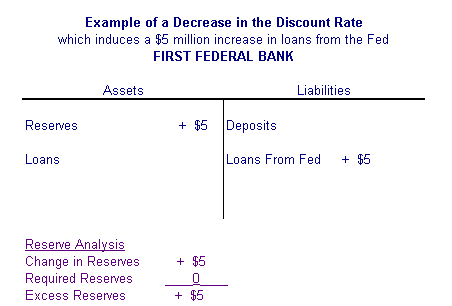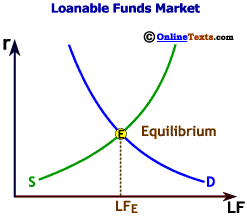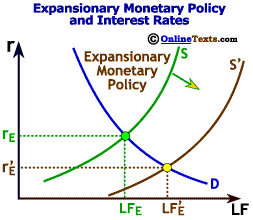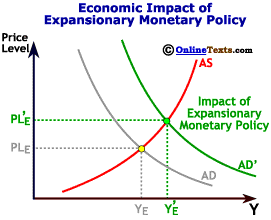The fed funds rate is the interest rate that is charged when one bank lends reserves to another bank. The Fed influences the fed funds rate indirectly via open market operations.
The discount rate is the interest rate at which the Federal Reserve lends funds to banks.
|
|
Tool #2: Change in the Discount Rate
Sometimes banks need access to funding quickly. That is, bank operations may be sound, but a heavy depositor withdrawal, an unexpected delay of payment from a customers, or an attractive but unexpected loan opportunity leaves the bank without enough cash to meet its reserve requirements. A bank in this situation has two primary sources of funds. One source is the fed funds market, the interbank market for trading excess reserves. Banks who have excess reserves can lend those reserves to banks who are short of reserves. The interest rate that is charged when one bank lends reserves to another is called the fed funds rate. In fact, the fed funds rate is the primary interest rate target of open market operations. By changing the quantity of excess reserves in the banking system, the F.O.M.C. indirectly sets the fed funds rate. An open market purchase lowers the fed funds rate because the supply of excess reserves increases as banks replace government securities with reserves; conversely, an open market sale raises the fed funds rate as banks purchase government securities from the Fed with their excess reserves.
A bank needing reserves could also turn to the Federal Reserve's [Outside Econweb] discount window. If the Fed decides to lend to the bank, it charges an interest rate called the discount rate. The discount rate is the interest rate at which the Federal Reserve lends funds to banks. It is the only interest rate that the Fed sets directly. Borrowings from the discount window are short-term, usually with a maturity between one day and two weeks. Longer-term loans are discouraged except through a special seasonal borrowing program through which loans are available to small banks for up to nine months. All loans through the discount window are collateralized.
The Federal Reserve controls the discount rate in order to influence the supply of money in the economy. If the Federal Reserve lowers the discount rate, it is signaling to banks that it is loosening the money supply; consequently, banks will be more willing to make loans to customers and make up any shortage in reserves by borrowing from the Fed. Conversely, if the Fed raises the discount rate, it is signaling to banks that monetary policy is tightening and banks had better be more diligent about having enough reserves on hand. Lowering the discount rate increases the money supply; raising the discount rate contracts the money supply. Let's look at an example.
Suppose that the Fed decreases the discount rate by one percentage point, say, from six percent to five percent. This change might induce banks to borrow $5 million more in reserves from the Fed to fund additional loan opportunities. As Figure 3 illustrates, the $5 million is an asset that goes in the banks' reserves. The $5 million is simultaneously a liability--a loan from the Fed. The loan, however, carries no reserve requirements. The bank is free to lend out the entire $5 million provided that it has enough reserves to meet its required reserve ratio.

The discount window is the tool in which the Fed potentially acts as the lender of last resort. A prime example is the operations of the window following the terrorist attacks on September 11, 2001. Reserve Banks lent $45.5 billion to depository institutions on September 12, 2001, setting a single-day record. Why was there such a need for funds? In a potential crisis situation such as the terrorist attacks, depositors and businesses may panic by withdrawing funds in large quantities, causing a liquidity crisis at some banks. The discount window provided banks with quick, easy access to sufficient quantities of funds. The depositor panic never occurred, and the banks ended up not needing the majority of the funds, so they paid them back (with interest) to the Fed over the next several days. While it is true that open market operations could have provided liquidity in the banking system as well (and indeed open market operations supplemented the discount window borrowings), that process may not have been able to get funds quickly enough to particular banks facing panics. The Fed is often times the only organization willing to lend funds to a bank in a crisis situation.
Despite the potential power of the discount window as the lender of last resort, in "normal" circumstances it is a passive monetary policy tool. When the F.O.M.C. conducts open market operations to change the targeted fed funds rate by a given amount, it typically adjusts the discount rate by the same amount. Beginning January 9, 2003, the Federal Reserve implemented some changes to its discount window program. Previously, the discount rate was set 50 basis points below the fed funds rate, leading to the criticism that the Fed was subsidizing bank borrowing. Now, the discount window has two programs that replace the adjustment credit (short-term lending) program.
Primary credit is available to financial institutions that Reserve Banks deem to be in generally safe and sound financial condition. Normally, the credit will be granted on a "no questions asked" basis, and the interest rate charged will be 100 basis points above the federal funds rate. Secondary credit is available to financial institutions that are not eligible for primary credit. These institutions will be under supervisory scrutiny. The interest rate on secondary credit will be 50 basis points higher than the primary credit rate. Collateral requirements remain unchaged for both programs.
|







